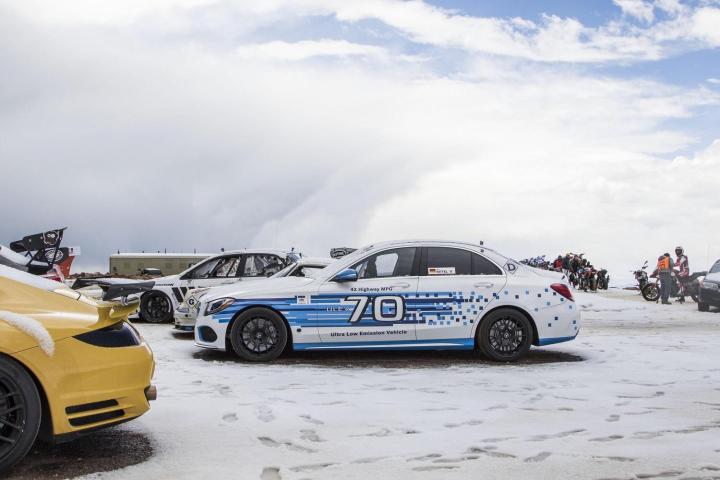
Surprisingly, the record-setting car wasn’t wearing an AMG badge on the trunk lid. Driven by Uwe Nittel, one of Mercedes’ test drivers, a near-production C250d 4Matic completed the 12.4-mile long course in just 11 minutes and 22 seconds, an all-time record for a diesel-powered car.
“Shoving a series-production diesel sedan with an automatic transmission up Pikes Peak sounds like a crazy idea, but it was a lot of fun. It shows that the preconceived notions about diesel engines are no longer relevant,” explained Nittel in a statement.
Diesel technology has come a long way in the last 30 years, and modern engine are much quieter, cleaner and more powerful than the oil-burners that were available during the 1970s and the 1980s. Designed largely for the European market, the C250d is powered by a turbocharged 2.1-liter, four-cylinder engine that makes 201 horsepower and a healthy 369 foot-pounds of torque.
Power is sent to all four wheels via a seven-speed automatic transmission. When driven with a light right foot, the turbodiesel returns up to 34 mpg in a mixed European cycle, a figure that makes it more efficient than many hybrids on the market today. However, there are over 150 bends in the Pikes Peak course so it’s safe to assume that hybrid-like economy was not achieved during the race.
The record-setting C’s engine and transmission were both bone stock, but the car featured a stripped-down interior to keep weight in check and a number of safety-related add-ons such as a full roll cage, a fire extinguishing system, beefier brakes all around and a set of ultra-high-performance tires.
Mercedes is not currently planning on selling the C250d in the United States, but it has confirmed the C family will be expanded next February with a diesel-powered model dubbed C300d. The oil-burning compact is expected to make its public debut either next November in Los Angeles or early next year at the Detroit Motor Show.
Editors' Recommendations
- 2025 Mercedes-Benz G580: range, price, release date, and more
- 2025 Mercedes-Benz EQS sedan gets new face, bigger battery
- Mercedes’ electric eSprinter isn’t just greener, it’s better
- How do you crash-test an EV with an 871-pound battery? Mercedes showed us
- Mercedes ‘Little G’ electric G-Wagon: Rumored design, release date



